Biology Reference
In-Depth Information
(B)
v3
v2
v1
0 ≤ v
i
≤ v
max
(A)
(C)
v3
A
v1
v
v2
v3
v3
C
D
v2
v2
B
v1
v
1
+ v
2
= v
3
v1
unbounded
(D)
v2
v3
v
v2
increasing z
v1
v1
maximize z = v1 + v2 (v3)
FIGURE 12.4
The successive addition of constraints on a three reaction system. By adding constraints, the size of the solution space decreases. In
this solution space, methods such as flux balance analysis (FBA) can be used to find putative flux values for each reaction. (A) Without any bounds on the
reaction fluxes (v1, v2, and v3 respectively), the solution space (blue) is unbounded. (B) Bounds are placed on the solution space by defining
the limitations of each reaction flux based on measured substrate uptake and enzyme capacity limits. (C) The imposition of mass balance constraints limits
the solution space even further. (D) By applying linear programming (LP) to optimize a cellular objective (in this case maximizing the sum of v1 and v2,
which corresponds to v3), the optimal flux levels can be computed. In genome-scale models, optimization is often carried out for the biomass function.
filled (e.g., by adding in a gene that changes an auxotroph to
an autotroph). However, reactions are occasionally added
when detailed data are not available, only when it is neces-
sary for network functionality (e.g., biomass precursor
synthesis). These are subsequently flagged with a low
confidence score. An appropriate treatment of model gaps
can greatly improve the accuracy of model predictions.
cycles occurring in which no material is lost to other
reactions outside the cycle. These are often called type III
extreme pathways
[41]
or 'loops' and violate true ther-
modynamics
[42]
. Multiple methods have been developed
to identify loops and remove them from a model
[43
e
45]
.
If loops exist, reaction directionality can be constrained to
break them if experimental data support the proposed
changes to reaction directionality. Otherwise, iterative
limitation of the directionality of pathway reactions can
prove effective
[42]
. Alternative methods for removing
thermodynamically infeasible loops have recently been
developed
[46
e
48]
. However, when removing loops, care
must be taken to avoid reaction modifications that intro-
duce new pathway gaps or that affect the model's accuracy
in replicating physiological data (e.g., growth rate or
secretion products, as discussed below).
Thermodynamic Tests
Once topological assessment is completed, efforts are
turned toward making the model as physiologically accu-
rate as possible. One concern with constraint-based models
is that the simplification of thermodynamic constraints (i.e.,
reactions are only declared as reversible or irreversible)
leads to the possibility of non-physiologically accurate







































































































































